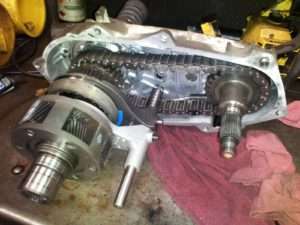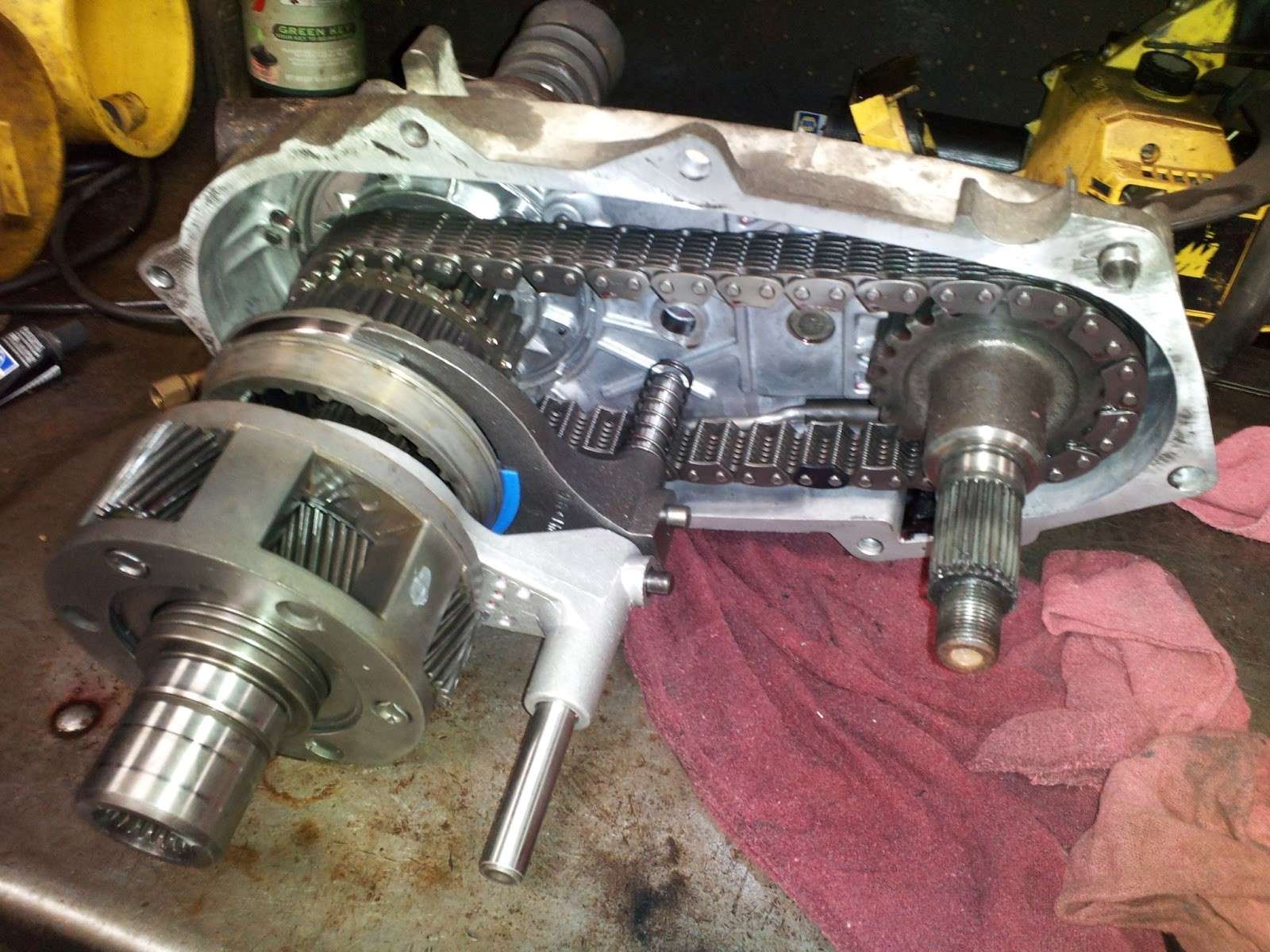A transfer case is a component of a four-wheel drive or all-wheel drive vehicle that transfers power from the transmission to the front and rear axles. It is essentially a second gearbox that allows the driver to select between different modes of operation, such as two-wheel drive or four-wheel drive, and high or low range. The transfer case works by splitting the power from the transmission and sending it to the front and rear axles in varying amounts, depending on the selected mode. In this article learn what is a transfer case and the many components that are part of one.
Transfer cases are crucial for vehicles that require four-wheel drive or all-wheel drive capabilities. Without a transfer case, a vehicle would be limited to only two-wheel drive, which could be dangerous and inefficient in certain situations. For example, in off-road environments, a four-wheel drive vehicle with a properly functioning transfer case can provide better traction and stability, allowing the driver to navigate rough terrain with greater ease. Transfer cases are also important for towing heavy loads or driving on slick or icy roads.
Jump to
A Brief Overview of Transfer Case History

The first transfer case was invented in the early 1900s by the Marmon Motor Car Company, which used a chain-driven transfer case to power both axles in its four-wheel drive vehicles. In the following decades, transfer cases became more advanced and sophisticated, with the development of different types of transfer cases, such as gear-driven and viscous coupling transfer cases. Today, transfer cases are an integral part of many four-wheel drive and all-wheel drive vehicles, and continue to evolve with the advent of electronic transfer cases and other technologies.
Components of a Transfer Case
Input Shaft
The input shaft is the first component of the transfer case that receives power from the transmission. It is connected to the transmission output shaft and transmits power to the rest of the transfer case.
Output Shaft
The output shafts are the components that transfer power from the transfer case to the front and rear axles. They can be located on either side of the transfer case and can have different speeds and torque capacities.
Gears
Gears are an essential component of the transfer case and determine the mode of operation, such as two-wheel drive or four-wheel drive. They are responsible for changing the direction of the power flow and can be either chain-driven or gear-driven.
Bearings
Bearings are important components of the transfer case that support the moving parts and help reduce friction and wear. They are typically made of steel or ceramic and require proper lubrication and maintenance to ensure optimal performance.
Seals
Seals are used to keep fluids, such as oil, from leaking out of the transfer case. They are located at various points throughout the transfer case and can be made of rubber or other materials.
Chain or Drive Shaft
The chain or drive shaft is the component that connects the front and rear output shafts and transfers power from one to the other. It can be either a chain or a drive shaft, depending on the type of transfer case.
Shift Linkage
The shift linkage is the component that allows the driver to select between different modes of operation, such as two-wheel drive or four-wheel drive, and high or low range. It can be a mechanical linkage or an electronic system, depending on the type of transfer case. Proper maintenance of the shift linkage is important to ensure smooth shifting and optimal performance.
Types of Transfer Cases
Part-time Transfer Cases
Part-time transfer cases are designed to be used only in four-wheel drive mode and are not intended for use on paved roads. There are two types of part-time transfer cases: 2-speed and single-speed. 2-speed transfer cases provide a low-range gear for increased torque and better traction in off-road environments. Single-speed transfer cases have a fixed gear ratio and are typically found on older vehicles.
Full-time Transfer Cases
Full-time transfer cases are designed to be used in both two-wheel and four-wheel drive modes and are intended for use on paved roads as well as off-road environments. There are three types of full-time transfer cases: center differential, viscous coupling, and electronic. Center differential transfer cases use a differential to allow the front and rear axles to turn at different speeds. Viscous coupling transfer cases use a fluid coupling to transfer power between the front and rear axles. Electronic transfer cases use sensors and a computer to determine when four-wheel drive is needed and engage the transfer case accordingly.
The selection of a transfer case type is based on the vehicle type and application. Part-time transfer cases are typically used on off-road vehicles that will not be driven on paved roads, while full-time transfer cases are used on vehicles that will be driven on both paved roads and off-road environments. The type of full-time transfer case selected will depend on the vehicle’s intended use, with center differential transfer cases being better for high-speed driving on paved roads, viscous coupling transfer cases being better for off-road environments, and electronic transfer cases providing the most advanced and versatile capabilities. It is important to select the appropriate transfer case type for a vehicle to ensure optimal performance and safety.
Transfer Case Functionality
The main function of a transfer case is to distribute power from the transmission to the front and rear axles of a vehicle. By engaging the transfer case, power can be transferred to all four wheels, increasing traction and improving the vehicle’s handling in slippery conditions.
While four-wheel drive and all-wheel drive are often used interchangeably, there is a difference in functionality. Four-wheel drive is typically used in off-road vehicles and is engaged manually when needed. All-wheel drive, on the other hand, is used in vehicles designed for on-road use and is engaged automatically based on road conditions.
The transfer case can be engaged manually or automatically, depending on the type of vehicle and transfer case. In manual systems, the driver must physically engage the transfer case by using a lever or button. In automatic systems, sensors detect the need for four-wheel drive and engage the transfer case automatically.
The transfer case plays a crucial role in off-road and towing situations. When driving off-road, the transfer case distributes power to all four wheels, increasing traction and allowing the vehicle to navigate through difficult terrain. When towing, the transfer case can be engaged to provide additional power to the rear wheels, improving the vehicle’s towing capacity and stability. Proper use and maintenance of the transfer case is essential for safe and effective off-road and towing experiences.
Maintenance and Repair of Transfer Cases
One of the most important aspects of transfer case maintenance is ensuring proper fluid levels and regular fluid changes. Over time, transfer case fluid can break down and become contaminated, leading to poor performance and potential damage to the transfer case. Regular fluid changes can help prevent these issues and extend the life of the transfer case.
There are several common problems that can occur with transfer cases. These include leaks, noise or vibration, and difficulty shifting. Leaks can be caused by damaged seals or gaskets, while noise or vibration may be a result of worn gears or bearings. Difficulty shifting can be caused by a variety of issues, including damaged shift linkage or a malfunctioning shift motor.
When problems arise with the transfer case, it is important to troubleshoot and diagnose the issue before attempting repairs. This may involve checking fluid levels and condition, inspecting seals and gaskets for damage, and performing a thorough visual inspection of the transfer case components.
In some cases, transfer case problems may be resolved through repair, such as replacing a damaged seal or gasket. However, in more severe cases, replacement of the transfer case may be necessary. It is important to consult with a qualified mechanic to determine the best course of action for the repair or replacement of the transfer case. Regular maintenance and prompt attention to any issues can help prevent costly repairs or replacements in the future.
Conclusion
Transfer cases are an essential component in vehicles that use four-wheel drive or all-wheel drive. They play a crucial role in distributing power to all four wheels, improving traction and handling in a variety of driving situations, from off-roading to towing. Proper maintenance and repair of the transfer case is important for ensuring the safe and effective operation of the vehicle.
From understanding the components of a transfer case to the different types available, it is clear that transfer cases are complex and important components in four-wheel drive and all-wheel drive vehicles. Regular maintenance and prompt attention to any issues can help prevent costly repairs or replacements in the future.
As with many components in modern vehicles, transfer case technology is constantly evolving. Future developments may include improvements in efficiency, durability, and performance. Advancements in electronic systems may also lead to more advanced and precise control over power distribution, further improving handling and traction in a variety of driving conditions.
Transfer cases are essential components in four-wheel drive and all-wheel drive vehicles, providing power distribution to all four wheels and improving traction and handling in a variety of driving situations. Proper maintenance and repair of transfer cases is important for ensuring the safe and effective operation of the vehicle. With continued advancements in technology, the future of transfer cases looks promising for improved performance and efficiency.

My name is Tom Harris, founder of this blog. I’m a mechanical engineer with 20 years of experience in the automotive industry. I’m here to help you with your vehicle’s problems, easy fixes and share my insights and experience so that you can enjoy your rides more.

